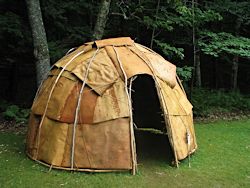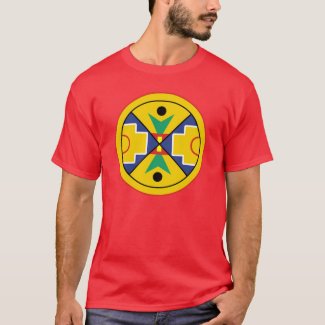Home :: US Tribes A to Z :: US Tribes A-B :: Aroostook Band of Micmac Indians of Maine
Who are the Aroostook Band of Micmacs?
The Aroostook Band of Micmacs and 28 other bands that are based in Canada comprise the Micmac Nation. The Micmacs are members of the Wabanaki Confederacy, an alliance that was forged among the Maliseet, Passamaquoddy, Penobscot, and Abenaki tribes in the 18th century.
Official Tribal Name: Aroostook Band of Micmacs
Address: Presque Isle, Maine
Phone:
Fax:
Email: tribalcouncil@micmac-nsn.gov
Official Website: http://www.micmac-nsn.gov/
Recognition Status: Federally Recognized
Traditional Name / Traditional Meaning:
Aroostook means “beautiful river.” Mi’kmaq is the plural form of Mi’kmaw, meaning “our kin-friends” or “my friends.”
Common Name: Micmac
Meaning of Common Name: Same as above.
Alternate names:
Mi’kmaq is the traditional spelling, and is the plural form of Mi’kmaw. Refers to all the collective Micmac bands, of which the Aroostook are just one band. Previously listed as the Aroostook Band of Micmac Indians. Formerly the Aroostook Band of Micmac Indians of Maine.
Alternate spellings / Mispellings:
Mic Mac, Micmack, Micmac, Mi’kmaq, Aroostook, Alloostook, Oolastook
Name in other languages:
Region: Eastern Woodland
State(s) Today: Maine
Traditional Territory:
Traditionally, the Micmac people have lived along the 400-mile-long St. John River, which runs along the Canadian border in northern Maine. Native gatherers inhabited this region as early as 12,000 years ago. Tribal history suggests that the Maliseet peoples and the Micmac jointly inhabited this area for several thousand years.
Confederacy: Wabanaki Confederacy
Treaties:
Between 1678 and 1752, the Micmacs signed numerous treaties with the Colony of Massachusetts.
Mi’kmaq Treaties on Trial: History, Land, and Donald Marshall Junior
Reservation: Aroostook Band of Micmac Trust Land
No federally established reservations. Without reservation status, since their recognition, the tribe has acquired over 1,350 acres of land. The majority of tribal members live in the cities of Presque Isle, Caribou, and Houlton, Maine.
The Aroostook Micmac lands include a 188, 264, and 80 acre parcel in Caribou, 19 acres in Bridgewater, 104 acres in Littleton, 8 acres in Mount Vernon, 24 acres in Presque Isle (the Bonaire housing development with 69 units) and 4 acres in Connor (with 16 houses). The tribe also acquired 658 acres of land from the U.S. Air Force, Department of Defense, in Limestone. This latter parcel is part of the former Loring Air Force Base and has an active Superfund site contaminated with PCBs, heavy metals, petroleum products and chlorinated compounds.
Land Area: Approximately 1350 acres
Tribal Headquarters: Presque Isle, Maine
Time Zone: Eastern
Population at Contact:
Registered Population Today:
Approximately 1100 members of the Aroostook Band of Micmacs live within Aroostook County, located in Northern Maine. Additional Aroostook Micmacs live in Canada and are organized into a separate band with tribal government in Canada.
Enrollment requirements for the Aroostook Band of Micmacs
Genealogy Resources: The Genealogist’s Address Book
Government:
Charter: On November 26, 1991 after complex legal maneuvering and political lobbying the Aroostook Band of Micmacs finally achieved Federal Recognition with the passage of the Aroostook Band of Micmacs Settlement Act.
Name of Governing Body: Tribal Council
Number of Council members: 7
Dates of Constitutional amendments:
Number of Executive Officers: 4 – Chief, Vice Chief, Secretary, Treasurer
Elections:
The Aroostook Band of Micmacs holds tribal elections every two years. Annual meetings are held in April with nominations to government happening on odd numbered years.
Language Classification: Algic -> Algonquin -> Eastern Algonquin -> Micmac
Language Dialect: Micmac
The Mi’kmaq language (spelled and pronounced Micmac historically and now often Migmaw or Mikmaw in English, and Míkmaq, Míkmaw or Mìgmao in Mi’kmaq) is an Eastern Algonquian language. The language’s native name is Lnuismk, Míkmawísimk or Míkmwei (in some dialects).
Number of fluent Speakers:
Dictionary:
Origins:
As far as we know, from time immemorial the Micmacs have occupied the lands south and east of the Gulf of Saint Lawrence, the Maritime Provinces and other regions along the Atlantic Seaboard of Northeastern America.
Glooscap is the main figure in Wabanaki creation stories and legends. He made the world habitable for human beings and taught people to live wisely. Glooscap stories have been told and retold over many generations. In the 1800s Tomah Joseph etched the stories in birchbark. You will see his name spelled in many ways, including: Koluskap, Gluskap, Keloskape, Glooskap and Gluskabe.
Bands, Gens, and Clans
The Micmac Nation is composed of seven districts with 29 bands and a population of approximately thirty thousand. There are Aroostook bands on both sides of the Canadian-US Borders, the other bands are all in Canada. Members of the Aroostook Band have free border-crossing rights guaranteed under the Jay Treaty of 1794, but do not have dual citizenship.
Social Organization:
Related Tribes:
Maliseets, Passamaquoddy, Penobscot and Abenaki.
Traditional Allies:
Maliseets, Passamaquoddy, Penobscot, Abenaki
Traditional Enemies:
Competition stemming from the fur trade intensified existing rivalries between the Micmacs and the neighboring Abenaki people.
Ceremonies / Dances:
Modern Day Events & Tourism:
Each year, on the third weekend in August, the Aroostook Band of Micmacs celebrates the Mawiomi of Tribes which is dedicated to all people of Mother Earth. The word “Mawiomi” is derived from the Mikmaq language meaning “Gathering.”The event is intended to showcase beauty, strength, spirit and endurance of the Micmac peoples’ culture and tradition.
The three-day event shares Micmac traditions and culture through songs, dances, food and expressions. Each day, various themes will feature traditional/cultural activities such as:
- Sunrise Blessing Ceremony
- Traditional Meals
- Traditional Drumming and Dancing
- Traditional Micmac Sweat Lodges
- Traditional Native Craft Sales
- Childrens’ games
The Mawiomi event takes place at Spruce Haven, 214 Doyle Rd in Caribou, Maine
Museums:
While in Presque Isle, visit the Cultural Community Education Center and tour the interpretation area which contains an exhibit about the Micmac whose culture dates back 9000 years.
Legends / Oral Stories:
Finding Kluskap: A Journey into Mi’kmaw Myth
Art & Crafts:
The MicMac are known for a variety of traditional baskets made of splint ash wood, birch bark and split cedar. The Micmac are recognized as excellent producers of porcupine quill on birch bark boxes and wooden flowers made of strips of maple, cedar and white birch.
Animals:
Clothing:
Adornment:
Housing:
Micmac Bark Wigwam, Photo By
Cortomaltais,GFDL, via
Wikimedia Commons
The traditional Mic Mac house was a bark wigwam (pictured at left).
Subsistance:
Economy Today:
Into the 20th century, the Micmacs have supported themselves through seasonal labor, logging, river driving, blueberry raking, potato picking, and by selling splint basketry.
Religon Today: Roman Catholicism, Traditional Tribal Religon
Traditional Religion & Spiritual Beliefs:
Burial Customs:
This video explains many of the Mic Mac customs.
Wedding Customs:
Radio:
Newspapers:
Famous Micmac:
Catastrophic Events:
For Micmacs; disease, increased warfare, different tools and technologies, and new religions would change their culture forever.
Tribe History:
As early as 1607, the Micmac people participated in the fur trade with French traders. The Micmacs served as the first “middlemen” to the interior Native population for the European fur trade. Competition stemming from the fur trade intensified existing rivalries between the Micmacs and the neighboring Abenaki people.
In July, 1776, the Micmac and Maliseet tribes agreed to support the American revolutionary forces against the British.
In the News:
Further Reading:
After King Philip’s War: Presence and Persistence in Indian New England
The Micmac Indians of Eastern Canada
In Indian Tents – Stories Told by Penobscot, Passamaquoddy and Micmac Indians
First Nations, Identity, and Reserve Life: The Mi’kmaq of Nova Scotia
Song of Rita Joe: Autobiography of a Mi’kmaq Poet
